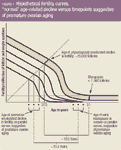Ovarian aging: Is there a "norm"?
Some women appear to have a gradual, yet premature, decline in ovarian function that is distinct from ovarian failure. In the author's experience, there is hope for successful pregnancy in these cases, with quick and correct diagnosis and the right treatment.
Female fertility declines with advancing age, principally because of changes in ovarian function. Ovarian aging always has been assumed to be the main culprit, but experience with human egg donation confirms that female fertility can basically be prolonged almost indefinitely, as long as "young" eggs are used in assisted reproduction.1
The decline in human fertility is predictable and can be quantified. Indeed, various authors have demonstrated that the downturn in women's fertility is the consequence of an age-dependent reduction in the number of remaining follicles, which starts during embryogenesis and continues. The initial pool of primordial follicles-at 16 to 20 weeks of fetal life-is believed to encompass approximately 6 to 7 million oocytes. At birth, the female's ovaries contain only 2 million oocytes, and by menarche, about 300,000 remain.2 That number is more than sufficient, as only about 450 monofollicular ovulations are required during a reproductive life of approximately 30 years.
Yet the number of remaining follicles does appear to matter, because when the follicular count falls to about 25,000-as it does in a physiologically normal ovary at approximately age 37.5-the decline in follicular numbers accelerates.3 Various authors, therefore, have suggested that what determines when a woman will experience menopause is not her age but how quickly her follicular count drops to approximately 1,000, the quantity at which menopause usually occurs.4 On average, that happens at age 51, or about 13 years after a woman reaches the 25,000-follicle milestone. In other words, at about age 37.5, a woman's fertility begins to accelerate, and about 13 years later, menopause sets in.

Does premature ovarian aging exist? Research strongly suggests that in some women, ovarian aging occurs prematurely, shifting the physiologic fertility curve in Figure 1 to the left.3-11 As a result, the various "milestones" in reproductive life occur earlier than normal, and how much earlier depends on how far to the left a woman's fertility curve has shifted.
The process of premature ovarian aging probably is reflective of early follicular loss and the pace of that loss. The periods between the various reproductive milestones may be fixed, but it appears that whatever a woman's age, when her remaining follicle count drops to 25,000, her decline in fertility will accelerate, followed by menopause approximately 13 years later.
Indeed, women with premature ovarian aging have been shown to experience early menopause, whereas those with an unusually large number of follicles-such as patients with polycystic ovarian syndrome-have been reported to enter menopause later.12-15
Infertility and ovarian aging If premature ovarian aging exists, then women with the condition would likely have decreased fecundity compared to their age-matched peers who have normal ovarian function. We would therefore expect that many such patients would be considered infertile, because they would not meet the expected time limits for successful reproduction. And indeed, many may be considered to suffer from so-called "unexplained" infertility since, at least superficially, they do not demonstrate any detectable diagnostic abnormalities. While premature ovarian aging, therefore, can be expected to represent a significant problem in any infertility practice, it can extend to the general ob/gyn practice, because women with infertility often seek help first from their general ob/gyn.
